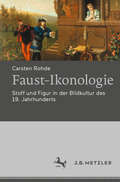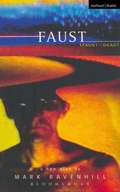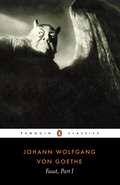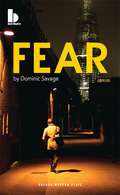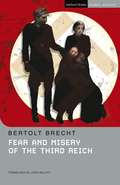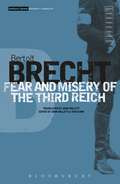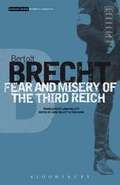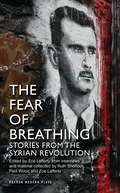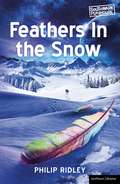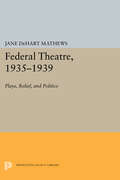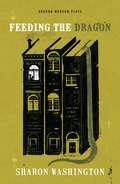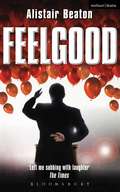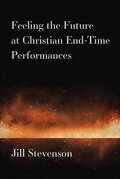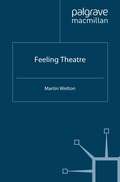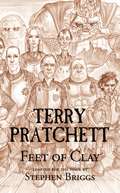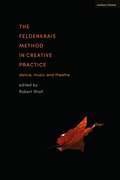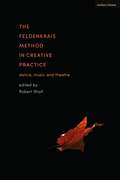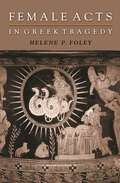- Table View
- List View
Faust-Ikonologie: Stoff und Figur in der Bildkultur des 19. Jahrhunderts
by Carsten RohdeDie Geschichte des Faust-Stoffes seit Goethe ist lange Zeit vor allem unter ideologischen Gesichtspunkten gedeutet worden. Die vorliegende Studie untersucht erstmals tiefergehend die populärkulturellen Resonanzen von Faust in der sich formierenden Medienmoderne des 19. Jahrhunderts. Die ‚Explosion der Bilder‘ sorgt dafür, dass Stoff und Figur in einer nie dagewesenen Vielfalt und Breite als visuelles Phänomen in Erscheinung treten. Faust wird zu einer populären Projektions- und Identifikationsfigur, die mit ganz unterschiedlichen Formen, Funktionen und Kontexten in Verbindung steht. Ihre Omnipräsenz in der Bildkultur des Jahrhunderts ist sowohl Spiegel als auch Katalysator dieser Entwicklungen.
Faust is Dead (Modern Plays)
by Mark RavenhillMark Ravenhill's Faust (Faust is Dead) is a dark and often brutally funny journey through a world of virtual realityThe world's most famous philosopher arrives in Los Angeles and is greeted as a star. In a round of chat show appearances, he announces the Death of Man and the End of History. When he meets up with a young man who is on the run from his father, a leading software magnate, they embark on a hedonistic voyage across America. But in the play's bloody conclusion, they discover that not all events are virtual."In Shopping and Fucking, Mark Ravenhill made theatre relevant to the Thatcher generation. Now he's put videos and Net-surfing in FAUST. And it's no less stunning." (The Guardian)
Faust is Dead: Shopping And F***ing; Faust Is Dead; Handbag; Some Explicit Polaroids (Modern Plays)
by Mark RavenhillMark Ravenhill's Faust (Faust is Dead) is a dark and often brutally funny journey through a world of virtual realityThe world's most famous philosopher arrives in Los Angeles and is greeted as a star. In a round of chat show appearances, he announces the Death of Man and the End of History. When he meets up with a young man who is on the run from his father, a leading software magnate, they embark on a hedonistic voyage across America. But in the play's bloody conclusion, they discover that not all events are virtual."In Shopping and Fucking, Mark Ravenhill made theatre relevant to the Thatcher generation. Now he's put videos and Net-surfing in FAUST. And it's no less stunning." (The Guardian)
Faust, Part I: Ein Mythos Und Seine Bearbeitungen (Faust)
by David Constantine GoetheGoethe's Faust reworks the late-medieval myth of Dr Faust, a brilliant scholar so disillusioned he resolves to make a contract or wager with the devil, Mephistopheles. The devil will do all he asks on Earth and seek to grant him a moment in life so glorious that he will wish it to last for ever. But if Faust does bid the moment stay, he falls to Mephisto and must serve him after death. In this first part of Goethe's great work the embittered thinker and Mephistopheles enter into their agreement, and soon Faust is living a life beyond his study and - in rejuvenated form - winning the love of the charming and beautiful Gretchen. But in this compelling tragedy of arrogance, unfulfilled desire and self-delusion, Faust, served by the devil, heads inexorably towards destruction.
Fausto
by Johann Wolfgang Von GoetheOriginalmente publicado en 1970 como Fausto, un fragmento, nada en la literatura alemana igualaba la extraña concepción y el poder concentrado de este drama. En su convicción de que ningún sistema filosófico puede aportar justicia al mundo, que la experiencia humana es irreducible a ninguna serie de conceptos y que la literatura puede reflejar ampliamente la ambigüedad de la vida, Goethe invita con esta obra a una comparación con los grandes filósofos como Nietzche o Kafka. Fausto se convirtió en una obsesión para Goethe, estuvo trabajando en esta obra por más de 60 años, terminándola apenas unos meses antes de morir. Goethe plantea un Mefistófeles cuyo carácter demoníaco reside exclusivamente en la no aceptación del dogma de lo establecido. Es una criatura que reflexiona en base a lo que observa, lo que le convierte en un maestro de lo que podríamos denominar "filosofía natural". Es una obra compleja y muy rica que soporta distintos acercamientos y esto se ha probado, ya que de esta historia han salido óperas, obras teatrales, comedias musicales y distintos experimentos teatrales modernos.
Fear (Oberon Modern Plays)
by Dominic SavageA contemporary tale of aspiration and greed, Fear explores the impact of a life-changing encounter between two Londoners from contrasting worlds. Taking a deeper look at what we value and fear, BAFTA award-winner Dominic Savage’s stage debut is a tense journey into the heart of some of our deepest urban anxieties.
Fear and Misery of the Third Reich (Student Editions)
by Bertolt BrechtBrecht's series of twenty-four interconnected playlets describe events which took place in ordinary German households in the 1930s. They dramatise with clinical precision the suspicion and anxiety experienced by ordinary people, particularly Jewish citizens, as the power of Hitler grew. Written in exile in Denmark and first staged in 1938 it was inspired in part by his recent trip to Moscow where he had been researching tasks for the anti-Nazi effort. This Student Edition features an extensive introduction and commentary and includes: a chronology of the Brecht's life and work; a synopsis of each playlet; an introduction to the context of the play; commentary on themes, characters, style and language; a review of the play in performance; notes on individual words and phrases in the text, and questions for further study.
Fear and Misery of the Third Reich (Student Editions)
by Bertolt Brecht John WillettBrecht's series of twenty-four interconnected playlets describe events which took place in ordinary German households in the 1930s. They dramatise with clinical precision the suspicion and anxiety experienced by ordinary people, particularly Jewish citizens, as the power of Hitler grew. Written in exile in Denmark and first staged in 1938 it was inspired in part by his recent trip to Moscow where he had been researching tasks for the anti-Nazi effort. This Student Edition features an extensive introduction and commentary and includes: a chronology of the Brecht's life and work; a synopsis of each playlet; an introduction to the context of the play; commentary on themes, characters, style and language; a review of the play in performance; notes on individual words and phrases in the text, and questions for further study.
Fear and Misery of the Third Reich (Modern Classics)
by Bertolt Brecht John WillettAlso known as The Private Life of the Master Race, this is a sequence of twenty-four realistic sketches showing how "ordinary" life under the Nazis was subtly permeated by suspicion and anxiety. Written in exile in Denmark and first staged in 1938 it was inspired in part by his recent trip to Moscow where he had been researching tasks for the anti-Nazi effort.
Fear and Misery of the Third Reich: Round Heads And Pointed Heads; Fear And Misery Of The Third Reich; Senora Carrar's Rifles; Trial Of Lucullus; Dansen; How Much Is Your Iron? (Modern Classics)
by Bertolt Brecht John Willett Tom KuhnAlso known as The Private Life of the Master Race, this is a sequence of twenty-four realistic sketches showing how "ordinary" life under the Nazis was subtly permeated by suspicion and anxiety. Written in exile in Denmark and first staged in 1938 it was inspired in part by his recent trip to Moscow where he had been researching tasks for the anti-Nazi effort.
Fear And Misery Of The Third Reich (PDF)
by Bertolt Brecht Tom Kuhn John WillettAlso known as The Private Life of the Master Race, this is a sequence of twenty-four realistic sketches showing how "ordinary" life under the Nazis was subtly permeated by suspicion and anxiety. Written in exile in Denmark and first staged in 1938 it was inspired in part by his recent trip to Moscow where he had been researching tasks for the anti-Nazi effort.
The Fear of Breathing: Stories from the Syrian Revolution (Oberon Modern Plays)
by Paul Wood Ruth Sherlock Zoe LaffertyAs thousands have been tortured, jailed, maimed or killed by the Syrian regime, The Fear of Breathing is not only a new play based entirely on verbatim reports from inside Syria itself, but is also a hard-hitting evocation of a life or death fight for freedom, experienced from the inside. To uncover these personal stories from the uprising, award-winning journalists Paul Wood and Ruth Sherlock, together with theatre director Zoe Lafferty, travelled into Syria covertly, circumventing the ban on journalists and restrictions on movement for all non-Syrians. They spoke to protesters as well as citizens who love President Bashar al-Assad and are terrified of a future without him.Featuring verbatim scenes, interviews, stories and film footage, The Fear of Breathing is a powerful and profoundly disturbing portrait of a revolution struggling to survive.
Feathers in the Snow (Modern Plays)
by Philip RidleyBeneath a sky full of stars a decision is made. This decision sets off an astonishing chain of events. And a journey involving a talking leopard, a greedy King, a magical bird, a tidal wave, a Sea Witch, a lost soldier, a devious dolphin, a war - and a trail of feathers in the snow . . . Feathers in the Snow, a family show by acclaimed playwright and children's author Philip Ridley, is an epic story of magic and migration. Covering over five hundred years - and with a huge cast - it explores how stories give meaning to random events and of our constant need to find somewhere we call 'home'. Feathers in the Snow reunites director David Mercatali with playwright Philip Ridley, following their collaboration in 2011 on Tender Napalm which was named one of the Guardian, Observer and Time Out's best shows of 2011.
Feathers in the Snow (Modern Plays)
by Philip RidleyBeneath a sky full of stars a decision is made. This decision sets off an astonishing chain of events. And a journey involving a talking leopard, a greedy King, a magical bird, a tidal wave, a Sea Witch, a lost soldier, a devious dolphin, a war - and a trail of feathers in the snow . . . Feathers in the Snow, a family show by acclaimed playwright and children's author Philip Ridley, is an epic story of magic and migration. Covering over five hundred years - and with a huge cast - it explores how stories give meaning to random events and of our constant need to find somewhere we call 'home'. Feathers in the Snow reunites director David Mercatali with playwright Philip Ridley, following their collaboration in 2011 on Tender Napalm which was named one of the Guardian, Observer and Time Out's best shows of 2011.
Federal Theatre, 1935-1939: Plays, Relief, and Politics
by Jane Dehart MathewsThe WPA Theatre Project-conceived as a relief measure, a work program, and an artistic experiment-enjoyed a brief but lively existence. With skill and sensitivity Mrs. Mathews explores its turbulent history from its ambiguous origins in 1935 to its tragic demise in 1939. The book recreate: the atmosphere of the era, and conveys a vivid sense of the Joys, frustrations, and personal sacrifices undergone by those dedicated few who recognized the need for an American People's Theatre.. Mrs. Mathews also provides a detailed account of the Congressional hearings which occasioned the disbanding of the. Project, and a fascinating portrait of Hallie Flanagan, the Projects colorful National Director.Originally published in 1967.The Princeton Legacy Library uses the latest print-on-demand technology to again make available previously out-of-print books from the distinguished backlist of Princeton University Press. These editions preserve the original texts of these important books while presenting them in durable paperback and hardcover editions. The goal of the Princeton Legacy Library is to vastly increase access to the rich scholarly heritage found in the thousands of books published by Princeton University Press since its founding in 1905.
Feeding the Dragon (Oberon Modern Plays)
by Sharon Washington'Once upon a time, there was a little girl who lived in a library...'Deep in the bowels of a New York Public Library lies a dragon: the monstrous coal furnace that Sharon's father, the live-in custodian, must feed every night.A moving examination of family secrets, forgiveness, and the power of language, Feeding the Dragon explores Sharon's life growing up in the library and the fire she never allowed to fade.
Feelgood (Modern Plays)
by Alistair BeatonAn outrageously funny satire on modern politics, New Labour and the fine art of spinAlistair Beaton's hilarious play, part farce, part biting satire, is set in the plush seaside hotel of a party conference. As anti-capitalist riots rage in the streets below, sinister and obsessive press secretary Eddie and young speech-writing aide Paul are trying to finalise the PM's conference speech. But Eddie's manipulative skills are to be tested far more by the scandal that George, dim-witted lord and close friend of the PM, gradually reveals - not helped by the arrival of Eddie's ex-wife and investigative journalist, Liz."Left me sobbing with laughter" (The Times)"Alistair Beaton rediscovers and restores the lost art of political satire in this hilariously timely portrait of new Labour fibbing and deceiving" (Benedict Nightingale, The Times)"Political satire was joyfully restored to the stage last night ... A satirical treat to savour" (Nicholas de Jongh, Evening Standard)
Feelgood (Modern Plays)
by Alistair BeatonAn outrageously funny satire on modern politics, New Labour and the fine art of spinAlistair Beaton's hilarious play, part farce, part biting satire, is set in the plush seaside hotel of a party conference. As anti-capitalist riots rage in the streets below, sinister and obsessive press secretary Eddie and young speech-writing aide Paul are trying to finalise the PM's conference speech. But Eddie's manipulative skills are to be tested far more by the scandal that George, dim-witted lord and close friend of the PM, gradually reveals - not helped by the arrival of Eddie's ex-wife and investigative journalist, Liz."Left me sobbing with laughter" (The Times)"Alistair Beaton rediscovers and restores the lost art of political satire in this hilariously timely portrait of new Labour fibbing and deceiving" (Benedict Nightingale, The Times)"Political satire was joyfully restored to the stage last night ... A satirical treat to savour" (Nicholas de Jongh, Evening Standard)
Feeling the Future at Christian End-Time Performances
by Jill C StevensonThe End is always near. The Apocalypse has sparked imaginations for millennia, while in more recent times, highly publicized predictions have thrust End-Time theology briefly into the spotlight. In the 21st century, fictional depictions of various apocalyptic scenarios are found in an endless stream of films, TV shows, and novels, while real-world media coverage of global issues including climate change and the migrant crisis often features an apocalyptic tone. Feeling the Future at Christian End-Time Performances explores this prevalent human desire to envision the End by analyzing how various live End-Time performances allow people to live in and through future time. ? The book’s main focus is contemporary Christian End-Time performances and how they theatrically construct encounters with future time—not just images or ideas of a future, but viscerally and immediately real experiences of future time. Author Jill Stevenson’s examples are Hell Houses and Judgement Houses; Rapture House, a similarly styled “walk through drama” in North Carolina; Hell’s Gates, an “outdoor reality drama” in Dawsonville, Georgia; Ark Encounter, a full-size recreation of Noah’s Ark; and Tribulation Trail, an immersive thirteen-scene drama ministry based on the Book of Revelation. The book’s coda considers similarities between these Christian performances and secular survivalist prepper events, especially with respect to constructions of and language about time. In doing so, the author situates these performances within a larger tradition that challenges traditional secular/sacred distinctions and illuminates how the End Times has been employed in our current social and political moment.
Feeling Theatre
by Martin WeltonWhy is it that in going to see plays we are also touched or moved by them, and is there more than metaphor involved in such claims? Considering these and other questions, this book examines a range of contemporary performance works in which performers and their audiences occupy a shared realm of feelings, in which the play is not always the thing.
Feet of Clay: A Novel Of Discworld (Discworld Ser. #17)
by Terry Pratchett Stephen BriggsSomeone is killing Lord Vetinari, Patrician of Ankh- Morpork. No one knows who, no one knows why and, worst of all, no one knows how – he just gets weaker and weaker. But it’s not just Vetinari – across the city, people are being murdered, but there’s no trace of anything alive having been at the crime scene. Commander Vimes, Head of the City Watch, is a man who hates ‘clues’. He and his team must question everyone – the butcher, the baker, the candlestick maker. In a city teeming with vampires, werewolves, dwarfs with attitude and golems, Vimes must solve the crimes and save the Patrician. As all children know, the way you get into a fantasy world is by accident… You go into the wardrobe, looking for somewhere to hide and – bingo. And that’s how Stephen Briggs found Discworld. In 1990, he wrote to ask Terry if he could stage Wyrd Sisters. That was the first time anyone, anywhere in the world, had dramatised Terry’s work. He had no idea it would go any further than one play (possibly two). But it did. So far, he has now adapted, staged and published twenty-two plays. He and Terry also worked together to produce the original Discworld Maps and Diaries, Nanny Ogg's Cookbook, The Discworld Companion (now called Turtle RecallThe Wit & Wisdom of Discworld.
The Feldenkrais Method in Creative Practice: Dance, Music and Theatre
by Robert ShollBringing together scholars and researchers in one volume, this study investigates how the thinking of the Ukrainian-Israeli somatic educationalist Moshe Feldenkrais (1904-84) can benefit and reflect upon the creative practices of dance, music and theatre. Since its inception, the Feldenkrais Method has been associated with artistic practice, growing contiguously with performance, cognitive and embodied practices in dance, music, and theatre studies. It promotes awareness of fine motor action for improved levels of action and skill, as well as healing for those who are injured. For creative artists, the Feldenkrais Method enables them to refine and improve their work. This book offers historical, scientific and practical perspectives that develop thinking at the heart of the Method and is divided into three sections: Historical Perspectives on Creative Practice, From Science into Creative Practice and Studies in Creative Practice. All the essays provide insights into self-improvement, training, avoiding injury, history and philosophy of artistic practice, links between scientific and artistic thinking and practical thinking, as well as offering some exercises for students and artistic practitioners looking to improve their understanding of their practice. Ultimately, this book offers a rich development of the legacy and the ongoing relevance of the Feldenkrais Method. We are shown how it is not just a way of thinking about somatic health, embodiment and awareness, but a vital enactivist epistemology for contemporary artistic thought and practice.
The Feldenkrais Method in Creative Practice: Dance, Music and Theatre
Bringing together scholars and researchers in one volume, this study investigates how the thinking of the Ukrainian-Israeli somatic educationalist Moshe Feldenkrais (1904-84) can benefit and reflect upon the creative practices of dance, music and theatre. Since its inception, the Feldenkrais Method has been associated with artistic practice, growing contiguously with performance, cognitive and embodied practices in dance, music, and theatre studies. It promotes awareness of fine motor action for improved levels of action and skill, as well as healing for those who are injured. For creative artists, the Feldenkrais Method enables them to refine and improve their work. This book offers historical, scientific and practical perspectives that develop thinking at the heart of the Method and is divided into three sections: Historical Perspectives on Creative Practice, From Science into Creative Practice and Studies in Creative Practice. All the essays provide insights into self-improvement, training, avoiding injury, history and philosophy of artistic practice, links between scientific and artistic thinking and practical thinking, as well as offering some exercises for students and artistic practitioners looking to improve their understanding of their practice. Ultimately, this book offers a rich development of the legacy and the ongoing relevance of the Feldenkrais Method. We are shown how it is not just a way of thinking about somatic health, embodiment and awareness, but a vital enactivist epistemology for contemporary artistic thought and practice.
Female Acts in Greek Tragedy
by Helene P. FoleyAlthough Classical Athenian ideology did not permit women to exercise legal, economic, and social autonomy, the tragedies of Aeschylus, Sophocles, and Euripides often represent them as influential social and moral forces in their own right. Scholars have struggled to explain this seeming contradiction. Helene Foley shows how Greek tragedy uses gender relations to explore specific issues in the development of the social, political, and intellectual life in the polis. She investigates three central and problematic areas in which tragic heroines act independently of men: death ritual and lamentation, marriage, and the making of significant ethical choices. Her anthropological approach, together with her literary analysis, allows for an unusually rich context in which to understand gender relations in ancient Greece. This book examines, for example, the tragic response to legislation regulating family life that may have begun as early as the sixth century. It also draws upon contemporary studies of virtue ethics and upon feminist reconsiderations of the Western ethical tradition. Foley maintains that by viewing public issues through the lens of the family, tragedy asks whether public and private morality can operate on the same terms. Moreover, the plays use women to represent significant moral alternatives. Tragedy thus exploits, reinforces, and questions cultural clichés about women and gender in a fashion that resonates with contemporary Athenian social and political issues.
